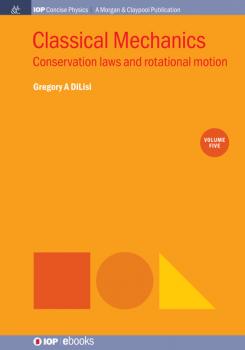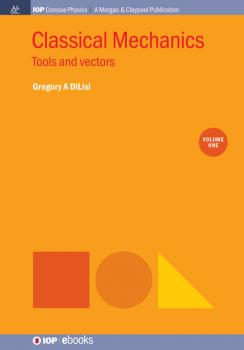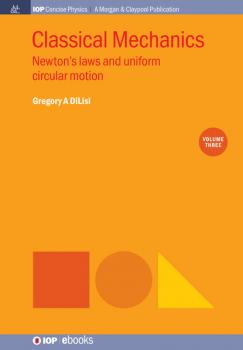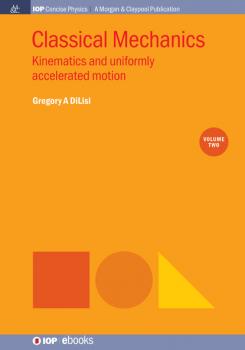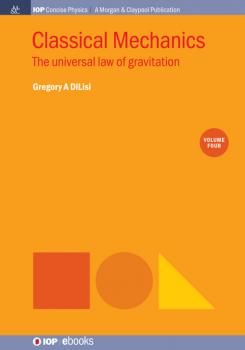ТОП просматриваемых книг сайта:
Gregory A DiLisi
Список книг автора Gregory A DiLisiАннотация
Classical Mechanics teaches readers how to solve physics problems; in other words, how to put math and physics together to obtain a numerical or algebraic result and then interpret these results physically. These skills are important and will be needed in more advanced science and engineering courses. However, more important than developing problem-solving skills and physical-interpretation skills, the main purpose of this multi-volume series is to survey the basic concepts of classical mechanics and to provide the reader with a solid understanding of the foundational content knowledge of classical mechanics. Classical Mechanics: Conservation Laws and Rotational Motion covers the conservation of energy and the conservation of momentum, which are crucial concepts in any physics course. It also introduces the concepts of center-of-mass and rotational motion.
Аннотация
Classical Mechanics teaches readers how to solve physics problems; in other words, how to put math and physics together to obtain a numerical or algebraic result and then interpret these results physically. These skills are important and will be needed in more advanced science and engineering courses. However, more important than developing problem-solving skills and physical-interpretation skills, the main purpose of this multi-volume series is to survey the basic concepts of classical mechanics and to provide the reader with a solid understanding of the foundational content knowledge of classical mechanics. Classical Mechanics: Tools and Vectors is simply about transmitting information. The conventions used to transmit certain types of numerical information are crucial concepts that must be addressed at the outset of any series on classical mechanics by discussing scalars versus vectors for example.
Аннотация
Classical Mechanics teaches readers how to solve physics problems; in other words, how to put math and physics together to obtain a numerical or algebraic result and then interpret these results physically. These skills are important and will be needed in more advanced science and engineering courses. However, more important than developing problem-solving skills and physical-interpretation skills, the main purpose of this multi-volume series is to survey the basic concepts of classical mechanics and to provide the reader with a solid understanding of the foundational content knowledge of classical mechanics. Classical Mechanics: Newton's Laws and Uniform Circular Motion focuses on the question: 'Why does an object move?'. To answer that question, we turn to Isaac Newton. The hallmark of any good introductory physics series is its treatment of Newton's laws of motion. These laws are difficult concepts for most readers for a number of reasons: they have a reputation as being difficult concepts; they require the mastery of multiple sub-skills; and problems involving these laws can be cast in a variety of formats.
Аннотация
Classical Mechanics teaches readers how to solve physics problems; in other words, how to put math and physics together to obtain a numerical or algebraic result and then interpret these results physically. These skills are important and will be needed in more advanced science and engineering courses. However, more important than developing problem-solving skills and physical-interpretation skills, the main purpose of this multi-volume series is to survey the basic concepts of classical mechanics and to provide the reader with a solid understanding of the foundational content knowledge of classical mechanics. Classical Mechanics: Kinematics and Uniformly Accelerated Motion focuses on the difference between asking, 'How does an object move?' and 'Why does an object move?'. This distinction requires a paradigm shift in the mind of the reader. Therefore, the reader must train themselves to clarify, 'Am I trying to describe how the object moves or why the object moves?'.
Аннотация
Classical Mechanics teaches readers how to solve physics problems; in other words, how to put math and physics together to obtain a numerical or algebraic result and then interpret these results physically. These skills are important and will be needed in more advanced science and engineering courses. However, more important than developing problem-solving skills and physical-interpretation skills, the main purpose of this multi-volume series is to survey the basic concepts of classical mechanics and to provide the reader with a solid understanding of the foundational content knowledge of classical mechanics. Classical Mechanics: The Universal Law of Gravitation focuses on the notion that forces act through their associated fields, which is first introduced when discussing Newton's universal law of gravitation. A huge conceptual leap is required from the reader: an object can cause another object to move without even touching it. This is a difficult concept to reconcile with our everyday experiences but it makes perfect sense when we realize that is exactly how the Earth acts on us. Gravity is able to pull on us even though we are not in direct contact with the Earth. Also, the concept of super-position (and when it is applicable) is introduced. Super-position is crucial to the development of problem-solving skills so it will be illustrated in a number of example problems.
Аннотация
Practically every display technology in use today relies on the flat, energy-efficient construction made possible by liquid crystals. These displays provide visually-crisp, vibrantly-colored images that a short time ago were thought only possible in science fiction. Liquid crystals are known mainly for their use in display technologies, but they also provide many diverse and useful applications: adaptive optics, electro-optical devices, films, lasers, photovoltaics, privacy windows, skin cleansers and soaps, and thermometers. The striking images of liquid crystals changing color under polarized lighting conditions are even on display in many museums and art galleries – true examples of 'science meeting art'. Although liquid crystals provide us with visually stunning displays, fascinating applications, and are a rich and fruitful source of interdisciplinary research, their full potential may yet remain untapped.

